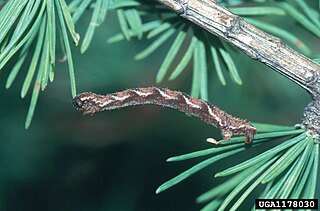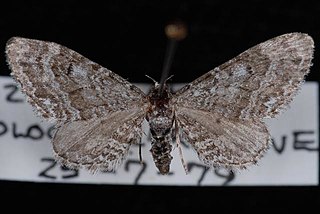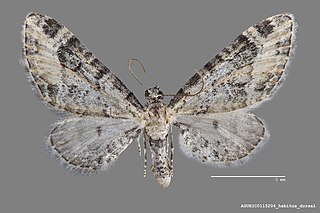
Freyer's pug is a moth of the family Geometridae. The species can be found in Europe, east to the Urals, the Russian Far East, Kazakhstan and China. It is also found in North America.

Eupithecia miserulata, the common eupithecia, is a moth of the family Geometridae. The species was first described by Augustus Radcliffe Grote in 1863 and it can be found in North America, from Ontario and Maine in the north to Florida, Mississippi, Louisiana and Texas in the south. It is also found in Arizona and California.

Eupithecia fletcherata, or Fletcher's larch looper, is a moth of the family Geometridae described by George Taylor in 1907. It is found in Canada and the north-eastern parts of the United States.

Eupithecia satyrata, the satyr pug, is a species of moth of the family Geometridae. It was described by Jacob Hübner in 1813. It is found from Ireland, through northern and central Europe east to all of Russia and central Asia and western Siberia to Tibet. It is also present in North Africa and North America.

Eupithecia pygmaeata, the marsh pug, is a moth of the family Geometridae. It is known from most of Europe, western and southern Siberia, the Russian Far East, northern Mongolia and North America .The species primarily colonizes floodplain and disused forests, bogs, river banks and marshy meadows. E. pygmaeata reaches up to 1800 meters in South Tyrol.

Eupithecia bryanti is a moth in the family Geometridae first described by Taylor in 1906. It is found from Alaska, the Yukon Territory, Alberta and British Columbia, through Washington, Oregon, Montana, Idaho, Wyoming and Utah to California.
Eupithecia nimbosa is a moth in the family Geometridae first described by George Duryea Hulst in 1896. It is widespread in the Rocky Mountains, from Arizona to the Canada–US border.

Eupithecia perfusca is a moth in the family Geometridae first described by George Duryea Hulst in 1898. It is found in western North America.

Eupithecia agnesata is a moth in the family Geometridae first described by Taylor in 1908. It is found in North America from California through Wyoming, Oregon and Washington to British Columbia.

Eupithecia placidata is a moth in the family Geometridae first described by Taylor in 1908. It is found in western North America from British Columbia south to California.

Eupithecia misturata is a moth in the family Geometridae first described by George Duryea Hulst in 1896. It is widely distributed in western North America.
Eupithecia indistincta is a moth in the family Geometridae first described by Taylor in 1910. It is found in North America in Quebec and throughout the northern Atlantic states. It has also been recorded from California.

Eupithecia olivacea is a moth in the family Geometridae first described by Taylor in 1906. It is found in North America from British Columbia south through Washington and Oregon to California.
Eupithecia helena is a moth in the family Geometridae. It is found from Arizona and New Mexico, through Utah to Montana.
Eupithecia tenellata is a moth in the family Geometridae. It is found in North Africa, Iran and the Arabian Peninsula.
Eupithecia subalba is a moth in the family Geometridae. It is found in Mexico.
Eupithecia submiranda is a moth in the family Geometridae. It is found in Suriname.
Eupithecia violetta is a moth in the family Geometridae. It is found in Mexico.
Eupithecia uvaria is a moth in the family Geometridae. It is found in Brazil.
Eupithecia westonaria is a moth in the family Geometridae. It is found in Mexico.











